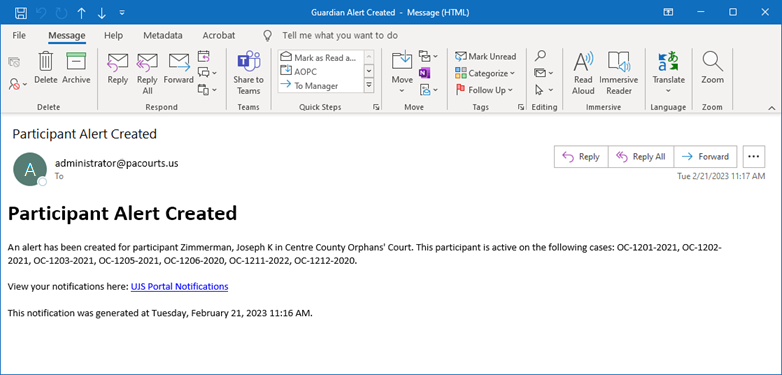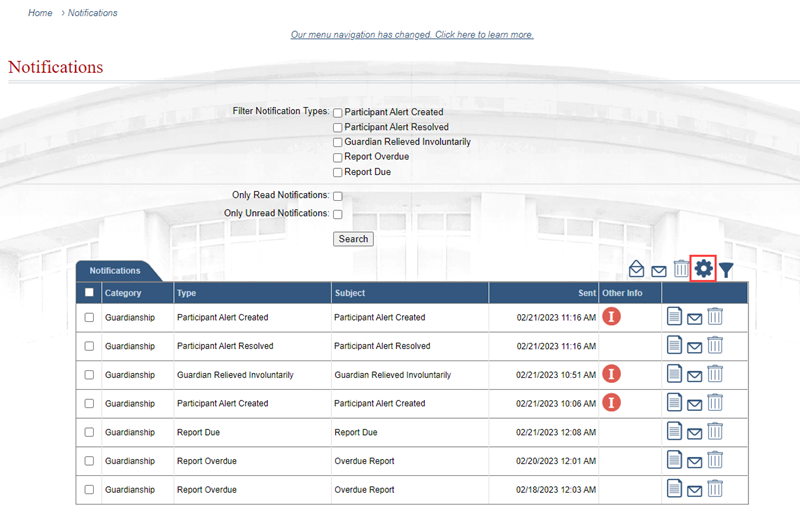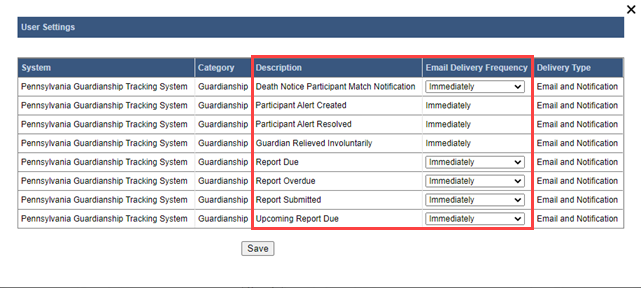Notifications
There are multiple types of notifications that are created based on case-related actions or circumstances related to active cases in GTS. In some instances, these notifications are informative and do not require you to take any responsive action. However, others, such as the creation of a participant alert, may be critical to address in a timely fashion. It is a good idea to form a business process for routinely checking and managing notifications.
Types of Notifications
The following represent the different notification types that you could receive:
Report-Related (county-specific)
-
Report Due - Notice that a Guardian of the Person or Estate report is one day overdue.
-
Report Overdue - Notice that a Guardian of the Person or Estate report is 20 days overdue.
-
Inventory Report Submitted - An inventory report has been successfully submitted in GTS and is ready to view for acceptance.
-
Report of Guardian of the Person Submitted - An estate report has been successfully submitted in GTS and is ready to view for acceptance.
-
Report of Guardian of the Estate Submitted - A person report has been successfully submitted in GTS and is ready to view for acceptance.
Guardian-Related
-
Guardian Relieved Involuntarily - This high priority notice indicates a guardian has been relieved involuntarily. This notification will be received in each county where the participant is a guardian on any active cases or on cases where they are the requested guardian but the case is not yet adjudicated.
-
Certification(s) Required - When either of the following circumstances apply to a professional guardian, this notification is sent requesting that they take action to add or update their guardianship certification information. All court staff receive a copy of this notification.
-
The individual is a professional guardian, their guardianship certification information has expired in the GTS, and they have been subsequently appointed as a guardian for another incapacitated person.
-
The individual is a professional guardian, they have no guardianship certification information entered in the GTS, and they have been appointed as a guardian for an incapacitated person.
-
-
Certification(s) Entered - If a guardian has previously received a Guardian Certification Expired notification, and has subsequently entered new or updated certification information, a Certification Entered notification is sent to the guardian and court staff to confirm that action. All court staff receive a copy of this notification.
Note: All high priority notifications are denoted by the existence of a red "I" icon ![]() in the Other Info column.
in the Other Info column.
Participant-Related
-
Death Notice Participant Match Notification - Indicates that the Department of Health issued a death notice for a case participant on an active case and a match has been found in GTS by their social security number or name and date of birth. This notification will be received in counties where the participant is on any active case in any role (interested party, guardian, incapacitated person, attorney, etc.). The purpose of this notification is to identify participants that are involved in other cases in the court system. The UJS Web Portal can be used to view docket sheets as an investigatory tool to ascertain the nature of the participant's role in the cases upon which they are a match and make a determination of any additional actions that may be needed on guardianship cases, if any.
-
Participant Alert Created - This high priority notification type is created in one of two circumstances:
-
When a Pennsylvania bar attorney, who is currently participating on one or more guardianship cases in your county (in any capacity), experiences a change that prohibits them from practicing law. The Pennsylvania Disciplinary Board, which is the agency responsible for regulating attorney conduct, provides the basis for these alerts by actively sending information to the GTS whenever an attorney’s status changes. For more information, see Participant Alerts (Attorney Status Changes).
-
When an alert has been added to the participant record for a guardian because of an indication of abuse, neglect, or financial exploitation. These alerts can only be created at the direction of a judge or other judicial authority. For more information, see Participant Alerts (Abuse, Neglect, Financial Exploitation). This notification will be received in counties where the participant is a guardian on any active cases, is the requested guardian on cases that are not yet adjudicated, or is part of an agency with cases in the county.
-
-
Participant Alert Resolved - This notification type is created in one of two circumstances:
-
When a Pennsylvania bar attorney, who had been previously assigned a status that prohibited them from practicing law, experienced a subsequent change in their status. For example, the attorney's status is returned to Active and they are once again permitted to practice law. For more information, see Participant Alerts (Attorney Status Changes).
-
When the court has investigated the problems surrounding an existing participant alert and they have been addressed to the court's satisfaction. These alerts can only be rescinded at the direction of a judge or other judicial authority. For more information, see Participant Alerts (Abuse, Neglect, Financial Exploitation). This high priority notification will be received in counties where the participant is a guardian on any active cases, is the requested guardian on cases that are not yet adjudicated, or is part of an agency with cases in the county.
-
-
Participant CMS Match Notification - This high priority notification is typically created when a proposed or active guardian in your county, working independently or for an agency, has been matched to a participant on a new Common Pleas or Magisterial District Court case or an existing one with an updated case disposition. The guardian's GTS cases and their corresponding Common Pleas or Magisterial District Court case history are identified in this notification. Less commonly, this notification is also sent when a guardian's participant match has been removed from the GTS because it no longer meets the corresponding criteria (i.e., they were found not guilty or their case was expunged). All court staff receive a copy of this notification.
Viewing Notifications
When the Notifications screen opens, your unread notifications display in a grid. By default, the notifications that display are sorted in order by date with the newest appearing first. A notification is marked as read by either opening it or by marking it manually as read. If you routinely receive a lot of notifications, it is recommended that you use the filter options above the grid to make this list more manageable.
Open Notifications
Open a notification to view the details. Opening a notification also marks it as read automatically. To open a notification, perform the following:
|
1. |
Locate the notification in the grid that you want to open. |
|
2. |
Click on the View Notification icon |
|
3. |
Review the notification. When finished, click the "X" in the upper-right corner of the popup to return to the Notifications screen. The notification that was opened now appears as read. |
Marking Notifications as Read or Unread
Unread notifications display before those that have been read, by default. The most recently received notifications display at the top of the list. You can manually mark notifications as read if you wish to review them again later so you do not want to delete them. Also, since notifications are automatically marked as read when they are opened, you may wish to mark some as unread so that they remain at the top of the notifications grid for ease of locating them later. To mark notifications as read or unread, perform the following:
|
1. |
Click the checkbox in the grid for the notifications you want to mark as read or unread. Alternatively, to select all the displayed records, use the Select/Deselect All checkbox appearing to the left of the Category column name. |
|
2. |
Click the Mark Selected Read icon |
Filtering Notifications
You can limit the notifications displayed in the grid in multiple ways:
-
Filter Notification Types - Use the checkboxes to limit your notifications to one or more of the available Types and click the SEARCH button. To remove an applied filter, deselect one or more checkboxes and click SEARCH.
-
Only Read/Unread Notifications - Use the checkboxes to limit your notifications to those that fall into one of these two categories and click the SEARCH button. To remove an applied filter, deselect one or more checkboxes and click SEARCH.
-
Filter icon
 - Use this option with care if you receive a lot of notifications. This function only filters the notifications that appear in the grid, which does not display more than 500 at any one time. Using one of the other two filter options would be preferable since it would apply to all your notifications, regardless if they appear in the grid.
- Use this option with care if you receive a lot of notifications. This function only filters the notifications that appear in the grid, which does not display more than 500 at any one time. Using one of the other two filter options would be preferable since it would apply to all your notifications, regardless if they appear in the grid.
Deleting Notifications
You may wish to delete notifications you no longer need to refer to. To delete notifications, perform the following:
|
1. |
Click the checkbox in the grid for the notifications you want to delete. Alternatively, to select all the displayed records, use the checkbox appearing to the left of the Category column name. |
|
2. |
Click the Delete icon |
Note: All unread notifications that are more than 60 days old (based on sent date) are deleted by the GTS automatically.
E-mail Notifications
The GTS is designed with the understanding that you won't be logged into PACFile continuously to await the arrival of Dashboard notifications. With this in mind, to improve the effectiveness of the communication process, all notifications received through the Dashboard are also communicated simultaneously through e-mail.
These e-mails are sent to the address you associated with your UJS Web Portal account. This address can be verified or changed in the Manage Account screen.
These secondary communications are intended to make you aware that an action has occurred and provides a link that encourages you to login to the GTS to view any specific information that is being maintained securely.

Manage E-mail Notification Settings
The GTS Dashboard provides access to various notification categories that announce various report or guardian-related actions. Any time an action is completed that triggers a notification, it automatically appears through your Dashboard and, if you did not previously unsubscribe from the feature, a corresponding e-mail is sent to the address associated to your Web Portal account.
While your Dashboard is intended to ensure that all your notifications are available to view through the GTS, the Settings icon ![]() has been added to the Notifications screen allows each person to control the frequency of the corresponding e-mails received for most notification types.
has been added to the Notifications screen allows each person to control the frequency of the corresponding e-mails received for most notification types.

After clicking this new icon, the User Settings screen displays each of the possible notification types you are eligible to receive. Aside each notification type is a dropdown that allows you to specify one of the following frequency settings:
-
Immediately - Any notification type set to this frequency ensures that an e-mail is sent to you at the time the corresponding action occurs and when the accompanying notification appears on your Dashboard. This is the default setting for all notification types.
-
Daily - Notification types set to this frequency trigger a single daily e-mail, typically sent in the morning, which contains the details of all applicable notices that were generated since the previous weekday morning.
-
Weekly - Notification types set to this frequency trigger a single weekly e-mail, sent on Monday mornings, which contains all applicable notices that were generated over the previous week.
-
Never - No e-mail notification is ever sent on the corresponding notification type.

Note: Given their importance, Participant Alert Created, Participant Alert Resolved, Guardian Relieved Involuntarily, and Participant CMS Match notices default to Immediately for all court staff and cannot be changed.
Note: Dashboard notifications are not affected by these settings and any settings made by one person have no effect on those of another.
